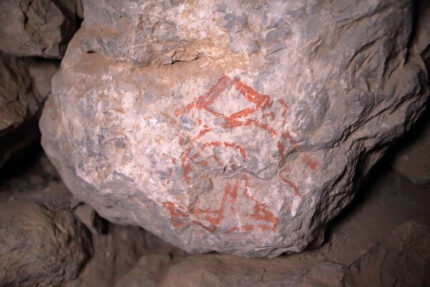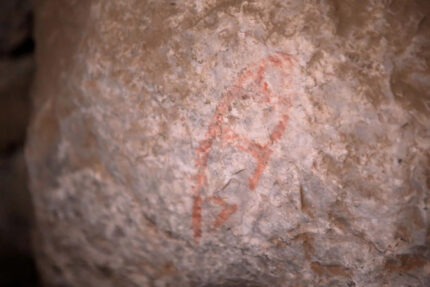 Some of the 3,500-year-old hieroglyphs discovered last year in the Yerkapı Tunnel in northern Turkey’s Çorum province have been deciphered. They are not religious inscriptions, as previously hypothesized, but rather a “made by” signature.
Some of the 3,500-year-old hieroglyphs discovered last year in the Yerkapı Tunnel in northern Turkey’s Çorum province have been deciphered. They are not religious inscriptions, as previously hypothesized, but rather a “made by” signature.
The 249 hieroglyphs were found on the massive stones of the tunnel in the ancient Hittite capital of Hattusa. They were painted with a red root dye (likely madder), and were preserved for thousands of years in the dark of the tunnel which has a remarkably even and temperate microclimate year-round.
Excavations of Hattusa began in Yerkapı in 1907, but despite dozens of archaeologists traipsing through its cool darkness for more than a century, none of them spotted the symbols until Dr. While Bülent Genç visited the tunnel with students to take some photographs in August of 2022.
 To decipher the hieroglyphs, researchers divided the symbols into six groups based on linguistic analysis of the elements of each of the hieroglyphs. They were able to decipher five of the groups, sufficient to explain the meaning of the inscription even though one group has yet to be cracked.
To decipher the hieroglyphs, researchers divided the symbols into six groups based on linguistic analysis of the elements of each of the hieroglyphs. They were able to decipher five of the groups, sufficient to explain the meaning of the inscription even though one group has yet to be cracked.
In the hieroglyphs found at the western and eastern ends of the tunnel, it is understood that a person named ‘Arişadu’ was responsible for the construction of the tunnel. This information is considered the most significant discovery regarding the tunnel’s construction.
There are also symbols for “Tuthaliya Mountain” and “road” in the hieroglyphs that can be seen on the western side of the tunnel. The combination of these symbols suggests that the tunnel was constructed as a road leading to Tuthaliya Mountain.
Hittite texts described Tuthaliya Mountain as a sacred mountain of such religious importance that several Hittite kings used it in their royal names.
Schachner stated, “These hieroglyphs appear as the signature, inscription, or an expression of ‘I did it’ by the person who built this tunnel. However, at the same time, we understand this; most likely, in the Hittite world, Anatolian hieroglyphs, this pictorial script, were much more widespread than cuneiform script.”
He also mentioned that Anatolian hieroglyphs were common in everyday life. “Cuneiform was more of an elite phenomenon, something used by the state, but with Anatolian hieroglyphs, we can anticipate various applications like everyday communication, city navigation signs, and many other things,” he said.